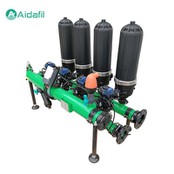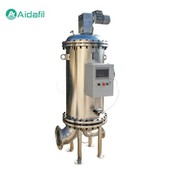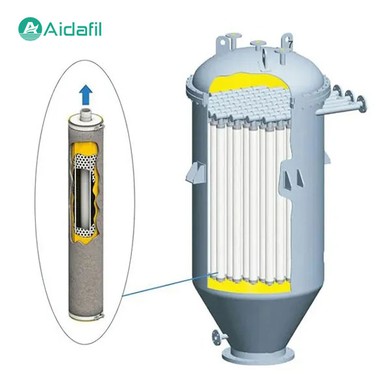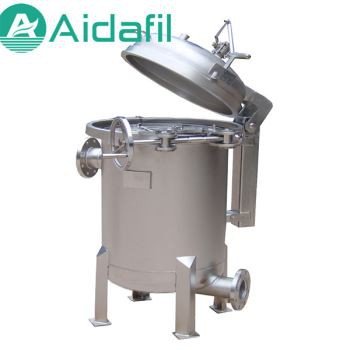
Manganese Sand Filter For Efficient Iron And Manganese Removal
Product Details
The Manganese Sand Filter For Efficient Iron And Manganese Removal is a specialized water treatment device designed to effectively remove harmful metal ions such as iron and manganese from water. Its operation is based primarily on physical adsorption and chemical redox reactions, utilizing specific filter media (e.g., natural manganese sand, quartz sand) and appropriate process conditions to efficiently eliminate iron and manganese, ensuring water safety and suitability.
Parameters
|
Rated flow |
1~200m³/h |
|
Working pressure |
0.75Mpa |
|
Working temperature |
5~50°C |
|
Backwash strength |
13~16L/m2S |
|
Backwash duration |
5~8min |
|
Material |
Q235 rubber / phenolic epoxy resin / 304, 316L |
|
Before filtration |
iron≤15mg/L manganese≤3mg/L |
|
After filtration |
iron<0.3mg/L manganese<0.1mg/L |
|
Voltage |
220V, 50Hz |
|
Dimension |
ф400~ф3200 |
Structure & Working Principle
An Manganese Sand Filter For Efficient Iron And Manganese Removal typically comprises the following components:
1. Inlet. Receives untreated water for processing, ensuring uniform distribution into the filter.
2. Distributor System. Including distribution channels, distribution holes, or distributor caps, which ensure even water flow throughout the filter bed, preventing localized high velocities that might disturb the filter media.
3. Filter Media Layer. Composed mainly of filter media such as manganese sand and quartz sand. Manganese sand, being crucial for iron and manganese removal, is rich in manganese dioxide, possessing strong oxidative properties. It oxidizes dissolved ferrous iron (Fe²⁺) and manganese (Mn²⁺) to insoluble ferric iron (Fe³⁺) and tetravalent manganese (MnO₂), which are then adsorbed onto or precipitated within the filter media.
4. Supporting Layer. Located beneath the filter media layer, consisting of larger gravel or pebbles, providing support to prevent the loss of filter media.
5. Collection System. Incorporating collection channels, branch pipes, etc., which gather filtered water after passing through the media, discharging it via the outlet.
6. Backwash System. Comprising backwash pumps, air compressors, drain valves, etc., used periodically to clean accumulated iron and manganese oxides, along with suspended solids, from the filter media surface, restoring its filtration efficiency.
During operation, raw water enters through the inlet and is evenly distributed by the distributor system onto the filter media layer. Within this layer, dissolved Fe²⁺ and Mn²⁺ are first oxidized by the manganese dioxide on the filter media surface, rapidly forming Fe(OH)₃ and MnO₂ precipitates, while some iron and manganese ions are adsorbed. Purified water permeates the media, collects in the supporting layer, and ultimately exits through the outlet. As the filter operates over time, the accumulation of iron and manganese oxides on the media surface will gradually increase, affecting filtration performance. At this point, the backwash system is activated, employing a combination of air and water to dislodge adhered substances from the media and flush them out with backwash water, rejuvenating the media's activity.
Features
1. Efficient Iron & Manganese Removal. Utilizing manganese sand rich in manganese dioxide as the filter medium, effectively oxidizes and adsorbs iron and manganese from water, achieving high removal rates compliant with drinking water standards.
2. Simple Operation & Easy Maintenance. The equipment is compact and highly automated, requiring only routine monitoring of water quality and pressure during normal operation, with periodic backwashing, without the need for chemical additives, reducing operating costs and environmental risks.
3. Broad Adaptability. Suitable for various water sources, including groundwater, surface water, etc., maintaining stable iron and manganese removal performance across a wide range of water temperatures, pH values, and alkalinity levels.
4. Long Service Life. High-quality manganese sand filter media exhibit good corrosion resistance and compressive strength, enduring wear, and with backwashing restoring its activity, extending the overall lifespan of the filter.
Applications & Precautions
The Manganese Sand Filter For Efficient Iron And Manganese Removal finds widespread use in:
1. Drinking Water Treatment. For water sources with excessive iron and manganese content, such as well water, spring water, etc., serving as a pretreatment device to ensure water safety for consumption.
2. Industrial Water Treatment. In industries like chemicals, food, pharmaceuticals, electronics, etc., for pretreating process water, preventing iron and manganese ions from affecting product quality and equipment.
3. Agricultural Irrigation. Mitigating adverse effects of excessive iron and manganese on crop growth and soil structure.
When using an iron-manganese sand filter, bear in mind the following points:
1. Rational Selection of Filter Media. Based on factors such as iron and manganese content in the source water, water temperature, pH, etc., choose the appropriate particle size, gradation, and manganese dioxide content for the manganese sand filter media.
2. Control of Operating Parameters. Maintain suitable filtration rates, backwash intensities, and frequencies to ensure both effective filtration and media longevity.
3. Water Quality Monitoring. Regularly test iron and manganese concentrations, as well as pH, alkalinity, etc., in both influent and effluent water, adjusting operational conditions as needed.
4. Periodic Maintenance. According to operational conditions, periodically clean backwash equipment, inspect component functionality, and replace worn parts or replenish filter media if necessary.
FAQ
1. Q: What is the function of a filter?
A: The main function of a filter is to remove solid particles, impurities, and harmful substances from liquids or gases, in order to achieve purification, clarification, and protection of equipment.
2. Q: How to choose a suitable filter?
A: When choosing a filter, factors such as the properties of the material being filtered (e.g., viscosity, temperature, corrosion), required filtration accuracy, processing capacity, operating pressure and medium, as well as the type, material, size, and installation method of the filter should be considered.
3. Q: What is the working principle of a filter?
A: The working principle of a filter mainly relies on physical screening, deep interception, absorption, or chemical reactions to remove impurities or harmful components from the material being filtered.
4. Q: How to maintain and care for a filter?
A: Maintenance of filters includes regular cleaning or replacement of filter elements, inspection of seals and fasteners, maintaining stable operating pressure, and avoiding overloading. Specific methods should be referenced from the filter's instruction manual and maintenance guides.
5. Q: What is the service life of a filter?
A: The service life of a filter depends on its working environment, processing volume, and filtration accuracy. Generally, when the filter's pressure drop reaches a certain value or the filtration effect decreases significantly, it needs to be replaced or cleaned.
6. Q: What should be paid attention to during filter installation?
A: During filter installation, attention should be paid to the directionality, ensuring that the fluid enters and exits from the correct ports. Also, the piping system should be cleaned before installation, and the filter should be securely fastened and sealed as required by the instructions.
7. Q: What is the replacement cycle for filters?
A: The replacement cycle for filters depends on their working conditions and filtration requirements, and is usually indicated by pressure difference indicators or timers. When the filter's pressure drop reaches the set value or the filtration effect decreases, it should be replaced in a timely manner.
Why Choose Us
· Professional manufacturer with many years' experience
· Good quality with competitive price
· OEM & ODM are welcome
· Various payment items are acceptable
· Good service by experienced manager
AIDA Philosophy
1. Management Concept:
· Satisfy the customers' demand --- Touch customers, trust with our products and services
· Make employees happy --- Pursue higher material and spiritual happiness
2. Company Mission:
· Focus on customer needs, provide best filtering solution
· To be the lifelong partner with customers
3. Corporate Vision:
· Become a global purification leadership brand
4. Values:
· Customer: Pursue the ultimate experience, enjoy excellent quality
· Team: Trust, responsibility, growth, win-win
· Work: Simple, sincere, efficient, dedicated
Hot Tags: manganese sand filter for efficient iron and manganese removal, China, factory, price, buy, oil separator filter for air compressor, hydraulic system oil filter cartridge, deep filter oil separators, compressed air filter element against oil vapor, Air Filter Element, Compressed Air Filter Element








